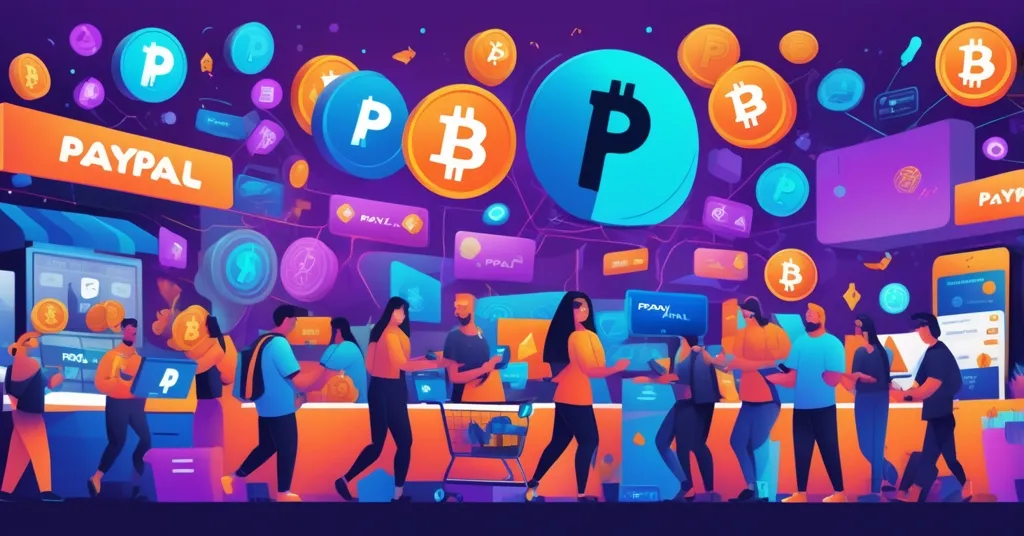PayPal’s ‘Pay with Crypto’ Launch: Bitcoin, Ethereum, 100+ Coins for U.S. Merchants

PayPal’s ‘Pay with Crypto’ Launch: Bitcoin, Ethereum, 100+ Coins, and a Bold Leap for Blockchain Payments
PayPal, a titan in the global payments game, has just unleashed a seismic update with its “Pay with Crypto” feature, slated to hit U.S. merchants in the coming weeks. This isn’t a timid toe-dip into digital assets—it’s a cannonball dive, supporting over 100 cryptocurrencies, integrating with powerhouse wallets like MetaMask and Binance, and capturing roughly 90% of the $4 trillion crypto market cap. Buckle up, because this could reshape how we think about money, commerce, and decentralization.
- Vast Coverage: Over 100 cryptocurrencies supported, from Bitcoin and Ethereum to Solana and stablecoins like USDT and USDC.
- Wallet Power: Seamless integration with MetaMask, Binance, Coinbase, and more for easy crypto spending.
- Fee Edge: A promotional 0.99% transaction fee for the first year, climbing to 1.5%—still beating the U.S. credit card average of 1.57%.
What PayPal’s ‘Pay with Crypto’ Brings to the Table
Let’s break down the nuts and bolts of this move. PayPal’s new feature allows U.S. merchants to accept payments in a sprawling lineup of digital assets—think Bitcoin (BTC), the kingpin of crypto; Ethereum (ETH), the backbone of smart contracts; Solana (SOL), a speed demon for cheap transactions; BNB from Binance; XRP tied to Ripple; and even niche players like memecoins. Add to that stablecoins like Tether (USDT) and USD Coin (USDC)—tokens pegged to the U.S. dollar to dodge the rollercoaster volatility of other cryptos—and you’ve got a buffet that appeals to just about every flavor of crypto user out there. With over 650 million crypto holders worldwide as their target, PayPal is swinging for the fences with this massive crypto payments rollout.
The integrations are just as impressive. We’re talking compatibility with major wallets and exchanges: MetaMask, a browser-based wallet for Ethereum and related tokens; Binance, the world’s largest crypto trading hub; Coinbase, a U.S. staple for buying and selling digital assets; plus OKX, Kraken, Phantom (a Solana favorite), and Exodus, a multi-asset wallet. More are on the way, signaling PayPal’s hunger to corner this market. For users, this means spending crypto straight from your preferred platform—no clunky workarounds needed, as detailed in their official Bitcoin and Ethereum payment integration update.
Merchant Benefits: Game-Changer or Slick Sales Pitch?
For merchants, PayPal is pitching a dream deal. Transaction fees start at a dirt-cheap 0.99% for the first year—a promotional hook—before settling at 1.5%. Compare that to the 2024 U.S. average for credit card processing at 1.57%, and it’s a no-brainer on paper. Then there’s the promise of lightning-fast cross-border payments, sidestepping the usual slog of high fees (often 3% or more) and delayed settlements that plague international trade. Curious about the perks? Check out some real-world merchant benefits of crypto payments discussed by users online.
Picture this: a small U.S.-based Etsy seller gets a Bitcoin payment from a buyer in Japan. Near-instant transfer, no extortionate fees eating into profits. That’s the vision PayPal’s chasing. They’re also dangling rewards for merchants who hold PYUSD, their in-house stablecoin, offering a 4% growth rate on funds kept in their ecosystem. Alex Chriss, PayPal’s President and CEO, laid it out with corporate swagger:
“Businesses of all sizes face incredible pressure when growing globally, from increased costs for accepting international payments to complex integrations. Using PayPal’s open platform, the business can accept crypto for payments, increase their profit margins, pay lower transaction fees, get near instant access to proceeds, and grow funds stored as PYUSD at 4% when held on PayPal.”
But let’s pump the brakes on the hype. Cheaper fees and faster transactions sound sweet, but how many small businesses even know what a crypto wallet is? A 2023 survey showed only about 13% of U.S. merchants have a clue about crypto payments. And while PayPal’s mum on specifics, integration could be a headache—will there be easy plugins for platforms like Shopify, or are we looking at a tech mess for the average mom-and-pop shop?
Shielding Merchants from Crypto Chaos
One smart move PayPal’s made is tackling the volatility issue head-on. Crypto prices can swing harder than a pendulum in a storm—Bitcoin dropping 20% overnight isn’t rare. To protect merchants, PayPal converts incoming crypto to PYUSD (their USD-backed stablecoin) and then to plain old U.S. dollars via centralized or decentralized exchanges before the funds hit the merchant’s account. This ensures businesses get stable fiat value, no matter how wild the market gets. It’s a practical shield, but it also means PayPal’s got its fingerprints all over the transaction flow—more on that later. For a deeper look at how this works, explore some community insights on PayPal crypto payment mechanics.
The Bigger Picture: Payment Giants and Blockchain
PayPal isn’t venturing into crypto payments alone. This move slots into a broader wave of traditional finance giants cozying up to blockchain tech. Stripe’s been testing stablecoin payments, Square’s Cash App has long supported Bitcoin transactions, and Mastercard recently partnered with Paxos and Fiserv (alongside PayPal) to push stablecoin integrations. It’s clear the payments industry sees digital assets—especially stablecoins—as the next frontier for cutting costs and speeding up global commerce. PayPal’s broad support for over 100 coins might give it a leg up over Square’s Bitcoin-only focus, but it also risks overcomplicating things with a cluttered roster, as highlighted in their 2023 U.S. merchant rollout details.
Zooming in on stablecoins, PayPal’s push for PYUSD—also integrated with the Stellar blockchain for remittances—shows an ambition to challenge heavyweights like USDT and USDC. Yet, let’s be real: PYUSD’s market share is a speck compared to Tether’s dominance. Building that trust and liquidity won’t happen overnight, no matter how many rewards they dangle. For a breakdown of how PYUSD stacks up, see this stablecoin comparison for business payments.
Risks and Roadblocks: What PayPal Isn’t Spilling
Before we anoint PayPal the savior of crypto commerce, let’s peek under the hood at the ugly bits. Regulatory uncertainty is a massive shadow over this rollout, especially in the U.S. where stablecoin oversight is a political hot potato. Bills like the Clarity for Payment Stablecoins Act are still kicking around Congress, and PayPal’s cautious fiat-conversion strategy feels like a preemptive hedge against potential crackdowns. Globally, the picture’s even messier—different countries, different rules. PayPal’s vague timeline for international expansion screams logistical or compliance headaches waiting to happen, as covered in ongoing regulatory updates on PayPal’s crypto journey.
Then there’s the privacy angle. PayPal’s track record on user data isn’t exactly a love letter to freedom—account freezes and data-sharing controversies have dogged them for years. When your Bitcoin payment gets funneled through their centralized conversion process, how much of your info are they scooping up? For crypto users who value anonymity, this could be a dealbreaker compared to pure decentralized solutions like Bitcoin’s Lightning Network, which lets you pay peer-to-peer with minimal middlemen.
Merchants face their own hurdles beyond tech literacy. User education is barely on PayPal’s radar in their shiny press releases. And what about crypto users? Are there hidden fees on our side of the transaction? Will every wallet play nice with their system long-term? PayPal’s playing chess, not charity, and we’d be naive to think there’s no catch buried in the fine print.
PayPal’s Crypto History: Not Their First Rodeo
This isn’t PayPal’s first dance with digital assets. They’ve been in the game since 2020, letting users buy, hold, and sell a handful of cryptos like Bitcoin and Ethereum in the U.S., later expanding elsewhere. Their launch of PYUSD in 2023 was a bigger bet on blockchain payments, though early crypto transaction fees drew flak for being steep. This “Pay with Crypto” feature feels like a calculated escalation, not a random pivot. But have they truly learned from past gripes, or are we just getting a shinier version of the same centralized control? For background on their broader history, take a look at PayPal’s evolution in digital payments.
Decentralization vs. Control: A Bitcoin Maximalist’s Grumble
As someone with a Bitcoin maximalist streak, I’ve got mixed feelings. On one hand, PayPal normalizing crypto payments is a huge win for adoption. Bitcoin as a legit payment method in mainstream commerce? Damn right, that’s the future we’ve been grinding for. It proves BTC can be more than a speculative asset—it’s hard money, the toughest there is. But the laundry list of altcoins and the heavy-handed push for PYUSD rubs me the wrong way. Bitcoin doesn’t need a stablecoin crutch or a corporate middleman to shine. PayPal’s conversion process smells like traditional finance dressed in crypto drag, not the trustless, peer-to-peer vision Satoshi laid out.
That said, I’ll tip my hat to altcoins filling niches Bitcoin doesn’t—and maybe shouldn’t—touch. Solana’s dirt-cheap fees are perfect for microtransactions like tipping creators, something Bitcoin’s network costs can’t always match. Ethereum’s smart contracts power automated subscriptions or decentralized apps, again outside BTC’s wheelhouse. These systems have a role in the financial revolution, even if they’re not the purest form of decentralized money. PayPal’s hybrid model—supporting decentralized wallets like MetaMask while keeping conversions under their thumb—might annoy purists, but it could be the gateway drug normies need before diving into raw, self-custodial Bitcoin transactions. Call it effective accelerationism: speed up the disruption, even if it’s a messy half-step.
The PayPal team framed their approach as a connectivity triumph, stating:
“Today, PayPal is simplifying cross-border commerce for merchants by connecting an unmatched combination of cryptocurrencies, digital wallets, and merchants worldwide.”
Sure, simplicity’s great, but it often comes at the cost of sovereignty. Isn’t cutting out the middleman the whole damn point of crypto? Still, if this onboards millions to the idea of digital money, I’ll stomach the compromise—for now. Chriss doubled down on the borderless vision, saying:
“By enabling seamless cross-border crypto payments, we’re breaking long-standing barriers in global commerce. These innovations don’t just simplify payments—they drive merchant growth, expand consumer choice, and reduce costs. This is the future of inclusive, borderless commerce.”
That’s a nice soundbite, but let’s see if the reality matches the PR gloss when regulatory red tape and user privacy concerns inevitably rear their heads.
Key Questions and Takeaways on PayPal’s Crypto Push
- How does PayPal’s ‘Pay with Crypto’ drive mainstream crypto adoption?
It’s a major boost, connecting over 650 million crypto users to everyday merchants, making digital assets a normal payment option with low fees and broad wallet support like MetaMask and Binance. - What’s the concrete upside for merchants in this setup?
Merchants score with fees as low as 0.99% initially, quicker global transactions, a wider customer base, and incentives like 4% growth on PYUSD holdings, outpacing traditional credit card costs. - Does this shield merchants from crypto’s wild price swings?
Yes, PayPal swaps crypto to PYUSD and then USD before funds reach merchants, ensuring they get stable fiat without gambling on Bitcoin or Ethereum’s volatility. - Why is PayPal so fixated on pushing PYUSD?
PYUSD is their chess piece to control the crypto ecosystem, rival USDT and USDC, and lock merchants into their platform with rewards, keeping funds in-house. - Will global rollout of ‘Pay with Crypto’ hit bumps?
No doubt—regulatory mazes, compliance chaos across borders, low crypto literacy, and scaling issues could stall PayPal’s worldwide ambitions despite the rosy outlook. - Is this a victory for decentralization or just centralized crypto in disguise?
It’s a mixed bag. Supporting decentralized wallets nods to DeFi (short for Decentralized Finance, financial systems on blockchain cutting out banks), but centralized conversions and PYUSD focus show PayPal’s still holding the reins tight.
PayPal’s latest play is a heavyweight punch for crypto payments, no denying it. It’s a tangible stride toward making Bitcoin and other digital assets legit tools for trade, not just speculative toys for traders. But don’t mistake this for the trustless, borderless utopia Bitcoiners crave—it’s a pragmatic, profit-driven pivot by a corporate behemoth. Revolutions take time, and if this gets more folks holding and spending BTC, even alongside a smorgasbord of altcoins, I’m game. Just don’t expect me to swallow the corporate spin without a healthy dose of side-eye. PayPal’s eyeing 650 million crypto users worldwide, but good luck explaining blockchain to your local diner owner who still worships cash. This is disruption, sure, but it’s on their terms—for now.



